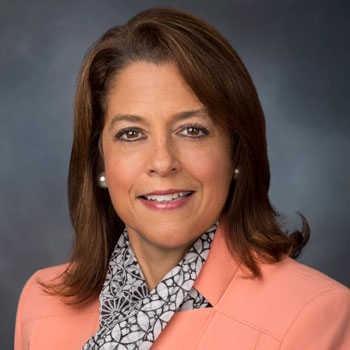Lisa Pendergast, executive director of the Commercial Real Estate Finance Council (CREFC), says this is a critical time for commercial real estate finance as industry participants navigate historical levels of inflation, rising interest rates, and overall uncertainty in the market.
Pendergast, who has more than 25 years of industry experience in the structured-finance markets, also sees ESG issues becoming an increasingly important consideration in commercial real estate finance. Pendergast spoke with REIT magazine on conditions in the commercial real estate bond markets today, what investors can expect, and why there’s a growing need for investors to be properly informed on climate change risk.
Given current market volatility, what can investors seeking higher yields in the commercial mortgage backed securities (CMBS) and commercial real estate collatorized loan obligation (CRE CLO) bond markets expect, nearer and longer term?
In the current highly uncertain market environment, investors are keenly focused on balancing credit quality and yield as they brace for what many believe to be rocky times ahead. Elevated inflation combined with softening economic data in the United States and globally means that returns can evaporate quickly.
Both the CMBS and CRE CLO markets have run into difficulties bringing transactions to market as investors demand higher yields on the bonds they buy given the environment, which ultimately drives loan rates and financing costs higher for commercial and multifamily real estate owners.
This has been particularly apparent in the single-asset/ single-borrower (SASB) CMBS market. We’ve seen a handful of borrowers pulling out of SASB transactions as their mortgage rates rise due not only to higher benchmark rates but also the wider spreads tacked onto those rates as investors demand higher yields for what they perceive to be more risk than was the case just a few months ago.
As rates rise and the cost of capital to owners and operators gets more expensive, how does this impact budgets, M&A, and overall investments in CRE as an asset class?
The 10-year Treasury, which most fixed-rate loans are pegged to, is hovering just under 3.0%, up from just 1.51% at the outset of the year. For structured finance CRE lenders, the combination of rising benchmark rates and wider spreads on CMBS and CRE CLO bonds makes this segment of the lending universe far less attractive when compared to other lender types.
With spreads widening on rate hikes and rising inflation, along with geopolitical strife, what should investors expect in the commercial real estate bond markets?
This is where it begins to get interesting. Recent weeks have brought more concern about the stall in economic growth over inflation. However, that sentiment has yet to alter the Federal Reserve’s plans to continue to hike the Fed funds rate, with recent minutes suggesting that a handful of 50-75-basis- point rate hikes is in the offing. Fed Chair Jerome Powell has talked about a ‘soft-ish’ landing; but it’s not going to be easy and there is a good chance that the Fed overshoots and pushes the U.S. economy into recession.
Why are agency CMBS spreads holding up better than non-agency CMBS spreads at this time?
While agency spreads are holding up better than private-label CMBS, they have not been immune to spread widening pressure. Year to date, Freddie K 10-year bonds (which are backed by multifamily properties) are wider by 23 basis points. That said, investors will migrate to the guaranteed agency CMBS market for their more defensive nature; think cash-flow reliability and heightened liquidity. In general, the multifamily collateral securing agency CMBS is viewed as being far more stable and reflective of continued sound demand for the asset class, especially given the surge in overall housing demand.
CREFC recently developed amendments to its Investor Reporting Package™ (IRP™) that investors use to evaluate prospective investments. The update includes disclosures related to sustainability and resilience. Tell us more about these climate amendments and the rationale behind developing them?
To be clear, CREFC’s efforts to enhance our IRP™ have yet to be completed. The task is complex, and our goal is to develop climate related disclosures that are most germane to the effort and verifiable. Key focus areas for this effort include property specific data related to resiliency, including third- party reported risks of climate perils and mitigants, resiliency certifications, green building certification information such as LEED, Energy Star, and GRESB. The list is a long one and we will continue to plug away on this issue, but it must be accurate; that’s job number one right now.
The Securities and Exchange Commission (SEC) recently proposed a rule requiring public companies to disclose their climate-related risks. If enacted, what impacts, could that have on investors as well as owners and operators?
CREFC supports the SEC’s efforts to regulate climate change disclosure through the promulgation of the Proposed Rule. Its ultimate goal aligns with ours, which is to ensure that commercial real estate investors in all forms are properly informed about climate change risk when making investment decisions. So it’s important to us that we be involved in facilitating the disclosure of consistent, comparable, and reliable information on climate change risks.
Going forward, should investors expect to see a lot more emphasis on sustainability, adaptation, mitigation, and resiliency when it comes to climate change and commercial real estate finance?
Absolutely. This issue has animated CREFC membership like no other, perhaps save COVID. It touches each and every component of the commercial real estate and multifamily property and finance markets; it’s top of mind for property owners, borrowers, lenders, and investors in commercial real estate-related debt. Not one of those entities disagrees with the notion of making every effort to significantly reduce carbon emissions.
The challenge is to identify the available data, be able to verify its accuracy, and correctly disseminate that information to investors and regulators. CREFC’s Sustainability Initiative has garnered significant numbers of our members to work with us to develop tracking and reporting regimes that work. It will take time, but this is what CREFC does best. We bring the right people into the room, gather and vet suggestions and views, and then proactively implement change.

